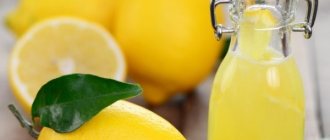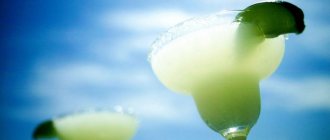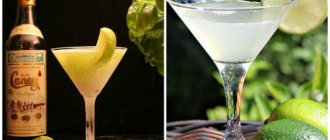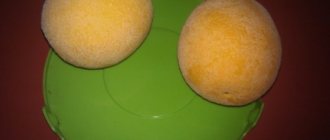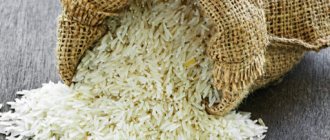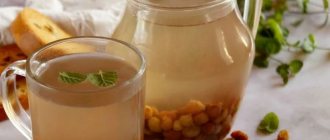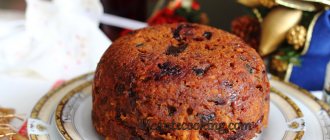History of the origin of sambuca
People first started talking about the drink more than 100 years ago. The first recipe for anise alcohol was created by the Italians as an experiment. The composition and taste were very different from the usual ones, since the anise tincture was supplemented with an extract from elderflowers. Modern sambuca does not contain the last ingredient. Each drink manufacturer conducts its own experiments with the recipe.
The liqueur gained fame in 1851. The author of the drink was the Italian Luigi Manzi. He introduced sambuca as an aniseed vodka that was good for the stomach. According to legend, the creator's distillery was located in Civitavecchia near the temple. There, the enterprising Luigi managed to make a hole in the floor and stored contraband alcohol. The additional warehouse helped him increase production volumes and keep the price of the drink in check. There is a version that the liqueur got its name from the phrase “santa buca”.
According to another version, the drink owes its name to the elderberry plant (Sambucus). Once upon a time, one of the main ingredients was used as a medicine, added to wine, and made into tinctures. There is also an opinion that the name comes from the Italian “sambuchelli”, which was the name given to Italian water-carrying boys. The most plausible theory for the appearance of the name came from the East. It is associated with the appearance of the Arabic drink “zammut”, created on the basis of anise.
Angelo Molinari brought sambuca production to the world level. In 1945, he updated the liqueur's recipe and began selling it as Sambuca Extra. Founded by a newly minted entrepreneur, the company has become a family business. Today it owns 70% of the Italian liqueur market. Until this time, the drink could only be found in some regions of Italy.
In 1950, Molinari sambuca entered the American market, but failed to gain a foothold on the shelves. The rich anise aroma is not familiar to Americans and the product was not in demand. It was decided to combine the liqueur with coffee, which has long been loved by residents of the United States. This was the impetus for the emergence of the only flavored sambuca (coffee) in the Molinari line. A drink with reduced alcohol content is added to hot coffee. To win the interest of a young buyer, various techniques for serving sambuca were developed. This is how “sambuca with flies” appeared - served with three coffee beans.
Photo by Julie Boyne on Unsplash
Sambuca production technology
Each manufacturing company keeps the recipe for the drink in the strictest confidence. It is known that the composition includes wheat alcohol, sugar syrup, elderberry extract, star anise, various herbs, purified water, fructose. The production technology includes several processes - infusion, distillation, etc. Alcohol is responsible for the strength of the liqueur. This figure varies depending on the type of drink (38-40 degrees). The viscous, sweetish taste comes from sugar and fructose, while the traditional aroma comes from the main ingredient – anise.
First, a special tincture is prepared. Seeds, anise fruits, herbs, elderberries are placed in a container and filled with alcohol. The container is tightly closed, the contents are mixed and sent to infuse in a warm place for 5 days. The contents of the tank are then passed through a filter and diluted with water. A third of the raw ingredients that were originally put in for infusion are placed into the prepared liquid and distillation begins.
Sambuca will gain its taste through slow distillation. The process is stopped at a certain amount of product yield in order to maintain the required strength level. The next step is mixing the prepared ingredients. Fructose is dissolved in boiling water and cooked for several minutes. The alcohol tincture is poured into the sweet hot liquid in several stages, mixing thoroughly. The sambuca cools down in the tank. Bottling occurs after natural cooling.
Coffee sambuca is produced using a similar technology. A special aroma and taste are achieved by adding Arabica beans. Some manufacturers produce cocktail liqueurs with the addition of licorice root, cardamom, coriander, various nuts, lemon balm, and rosemary. Thanks to the skillful combination of different berries, herbs and other components at the production stages, liqueur is divided into several types.
Sambuca apple or plum (TTK3736)
TECHNICAL AND TECHNOLOGICAL CARD No. Apple or plum sambuc
This technical and technological map was developed in accordance with GOST 31987-2012 and applies to the Sambuca apple or plum dish produced by a public catering facility.
Food raw materials, food products and semi-finished products used for preparing dishes must comply with the requirements of current regulatory documents, have accompanying documents confirming their safety and quality (certificate of conformity, sanitary-epidemiological report, safety and quality certificate, etc.)
3. RECIPE
Name of raw materials and semi-finished products \Gross\Net
| GROSS | NET | ||||
| Apples | 795 | 700 | |||
| or plums | 722 | 650 | |||
| Sugar | 200 | 200 | |||
| Gelatin | 15 | 15 | |||
| 2 pcs. | 48 | ||||
| Eggs (whites) | |||||
| Water (for gelatin) | 420 | 420 | |||
4. TECHNOLOGICAL PROCESS
After removing the seeds, apples (without seeds) or plums are placed on a baking sheet, a small amount of water is added and baked in an oven; then they are cooled and wiped. Add sugar and egg white to the resulting puree and beat in the cold until a fluffy mass is formed.
The prepared gelatin is placed on a water bain-marie, stirring, allowed to completely dissolve and filter, then poured in a thin stream into the whipped mass with continuous and rapid stirring with a whisk.
The mass is poured into molds and cooled. Sambuca is released in the same way as mousse.
Serving: The dish is prepared according to the consumer’s order and used according to the recipe for the main dish. Shelf life and sales according to SanPin 2.3.2.1324-03, SanPin 2.3.6.1079-01 Note: the technological map was compiled on the basis of a development report.
6.1 Organoleptic quality indicators:
Appearance - Characteristic of this dish.
Color - Characteristic of the products included in the product.
Taste and smell - Characteristic of the products included in the product, without any foreign tastes or odors.
6.2 Microbiological and physico-chemical indicators:
In terms of microbiological and physicochemical indicators, this dish meets the requirements of the technical regulations of the Customs Union “On the safety of food products” (TR CU 021/2011)
Proteins, g Fats, g Carbohydrates, g Calories, kcal (kJ)
Source
Types of Sambuca
Italian liqueur is produced by dozens of manufacturers in several modifications. Drinks take part in world alcohol competitions and take prizes, although there is no separate category for sambuca. The composition and taste are assessed in the Liquor group. Aniseed vodka, regardless of type, is a digestif and is recommended for consumption after meals. Its bright taste and aroma awakens taste buds and improves digestion. Sambuca is divided into three types.
White Sambuca: A clear drink with a distinct aroma of anise and lemon. White liqueur goes well with seafood, fruits and hard cheeses. A glass of white Sambuca has a slight coffee aroma. To fully reveal the taste, it is usually served with several coffee beans. Drink white sambuca in one gulp. The traditional liqueur has a characteristic aftertaste, giving a long-lasting feeling of vivacity.
Red Sambuca: Dessert alcohol has a rich red color and a bright fruity aroma thanks to the addition of fruits and red berries to the classic set of ingredients. Fruit components mute the anise component, making it thick, sweeter, and viscous. To make liqueur, certain knowledge of the proportions of mixing the component parts is required, so not all manufacturers are ready to take on such sambuca. Red sambuca is much less common in retail chains.
Black Sambuca: The dark shade is obtained by adding licorice extract. Tinting sambuca with a herbaceous plant gives the drink a special aroma that is barely perceptible to the average consumer. Liqueur with plant components is consumed both as an aperitif and as a digestif. Sambuca is produced in chocolate and coffee versions. The drink with the addition of chocolate has a characteristic sweetness and viscous structure. Several varieties of Arabica beans are added to coffee vodka.
Sambuca aging period
The quality of sambuca and other liqueurs only improves after prolonged aging. The taste becomes soft and pleasant, and the aroma becomes more refined. The prepared mixture is placed in a blending vat and infused for 24 hours to 2 months. The aging period depends on the type of sambuca and its components. The liqueur mixture is assembled from the ingredients in a specific sequence. Alcohol, herbs, elderberries are added to the anise and the whole thing is filled with alcohol. After thorough mixing, sugar syrup, chocolate, coffee beans, and sweet berries are added. After bringing the volume to the specified values, all components are mixed again.
This sequence of adding ingredients is necessary to reduce the alcohol concentration before adding sugar syrup, preventing the appearance of sediment. Natural coloring berries and herbs are added in the form of a water-alcohol mixture, synthetic ones - as an alcohol solution. Sugar syrup is added at a temperature not exceeding 20° C. This will protect the alcohol and aromatic substances from evaporation.
Part of the prepared mixture is sent for testing to confirm compliance with the recipe. If deviations are detected, the missing amount of ingredients is added to the drink to adjust the taste. Already aged sambuca cannot be supplemented, as this will worsen its organoleptic characteristics. After this procedure, the drink is sent for filtration and poured into containers.
At the production stages, sambuca is kept only in closed containers. When oxygen enters, a large number of esters quickly form, which worsens the taste of the drink. The quality of liqueurs after aging is influenced by their composition. Coffee sambuca is infused for up to 4 months, raspberry, cherry - up to 3 months, white classic aging will be enough for 1 month.
The finished product can be stored in a closed container from six months to several years. After the permissible period has expired, the drink changes color to a less saturated one. Each manufacturer provides accurate information on the product label. The opened drink should be drunk within 3 months. The bottle should be tightly closed and placed in a dark place with constant temperature and humidity.
Photo by Dmytro Ostapenko on Unsplash
Ingredients
To prepare this dessert, the housewife will need the following products:
- apples - 0.5 kg;
- sugar - 50 g;
- proteins - 2 pcs.;
- water - 200 ml;
- gelatin - 10 g;
- spices - 1 pinch.
The great thing about this composition is that all the products are publicly available, you can buy them at any time of the year at an affordable price. Any housewife can make apple sambuca. The requirements for the ingredients are not strict: any apples are suitable - red, yellow, green, sour or sweet, you can take more sugar if you want a sweeter dessert, spices are chosen at the discretion of the cook.
Best articles Sandwiches with sprats
From the above products you will get 7-8 160 ml servings of sambuca.
What to drink sambuca with
Sambuca in its pure form has a pleasant anise taste and an unusual smell. The drink goes well with other alcohol, snacks, syrups and additives. Thanks to its unique composition, the liqueur well sets off the tastes and smells of various dishes and individual products, giving them notes of herbal inflorescences and anise. In addition to mixing, liqueur is consumed in combination with other drinks and foods. The taste depends on the quality and strength of the alcohol itself. The following combinations will be successful:
- Recipe for Sambuca with milk. Liqueur and milk are poured into a tall glass alternately, avoiding mixing. First, a transparent glass is filled 2/3 with alcohol, the rest with milk. Due to the high density of sweet anise vodka, there is no natural mixing. To prevent milk from getting into the structure of the liqueur, it is poured along the wall of the glass using a wide knife or spoon.
- Recipe for Sambuca with warm coffee. Prepared chilled coffee is poured with sambuca. Coffee liqueur will give the whole composition a piquant bitterness and a simply stunning unique aroma.
- Recipe for Sambuca with fruit juice. White sambuca goes well with citrus juices. The ideal option is lemon and lime juice. It is recommended to drink red sambuca with sour berry juices.
- Recipe for Sambuca with sparkling water. In one glass of soda, the anise liqueur takes on a light, refreshing hue. The low-alcohol drink perfectly quenches thirst and does not get you drunk. When mixed with water, sambuca becomes cloudy, which does not affect the quality of the drink, but indicates the content of a large amount of essential oils.
Since sambuca is a rather strong alcoholic drink, drinking it without a snack is not recommended. The liqueur goes well with meat and fish dishes, cheeses, sandwiches, red caviar, and olives. Sambuca can be eaten with various sweets. Chocolate, sweets with milk filling, and nuts go well with coffee sambuca. An aperitif requires the subsequent consumption of a significant amount of high-calorie food.
Red sambuca is often served with candied berries - raspberries, cherries. Pastries with sweet fillings and fruit salads are suitable as snacks. White liqueur, which does not have a particularly pronounced aroma, is drunk with candied fruits and dried fruits. To reduce sweetness and make the drink stronger, liqueur is mixed with neutral alcohol, for example, vodka, gin, rum. Cigars are not served with Sambuca in any form. Tobacco products will interrupt the aroma and hopelessly ruin the taste of the drink.
Little secrets
Preparing apple sambuca is a very simple process. Even an inexperienced housewife, even a schoolgirl, can cope with this. But, like any other dish, this dessert will turn out more tender and tastier if you know some tricks.
To get apple sambuca right the first time, you need to consider the following:
- very carefully separate the yolks from the whites;
- if the whites are pre-cooled, they will whip better;
- gelatin should not be allowed to boil;
- If you prepare apple sambuca from green or red apples, the dessert will turn out with a grayish tint; if you make it from yellow apples, it will be cream-colored.
Chefs have the following requirements for finished sambuca: sweet but not cloying taste, smell of baked apple, light color with a slight creamy tint, loose jelly-like consistency.
Using this recipe, you can prepare sambuca from any fruit or berries.
How to drink sambuca correctly
Anise liqueur cannot boast of a wide range. You can diversify your taste sensations through the ways of consuming the drink, of which there are many. Serving sambuca looks equally impressive both in cocktails and in its pure form. In order for elite alcohol to be enjoyable, it is important to know how to drink it correctly.
The traditional way to serve white sambuca is “with flies”. This is how the inventors themselves drank the drink in Italy. Three coffee beans are added to the liqueur - symbols of health, wealth, and happiness. Arabica plays the role of a snack, highlighting the piquant, natural taste of sambuca. Italians also like to create a full-fledged drink by mixing liqueur with hot coffee in equal proportions. The liquor here acts as a sweetener and flavoring agent. The serving method is called Caffe corretto.
In many bars around the world, sambuca is served in its pure form, simply by setting the contents of the glass on fire. For greater effect, use a cognac glass, an elongated glass, napkins, straws, a saucer, and coffee beans. The original filing process looks beautiful and unusual. Sambuca is set on fire in a glass, the burning drink is poured into the glass, swirled for a few seconds and allowed to drink. After that, the fragrant vapors must be drawn in through a special structure of a napkin and a straw.
To reduce the time for preparing a burning drink, they came up with the idea of drinking it from simple shot glasses. 3 grains are placed in sambuca and set on fire. After cooling, the warm liqueur is drunk in one gulp and the Arabica beans are chewed. The serving glass should be made of durable glass with thick walls. Cold sambuca is drunk after meals to improve digestion. To achieve a better effect, the liqueur is even placed in the freezer.
You can also consume sambuca in a more original way - drink it while it is burning in your mouth. It is necessary to hold a little liquor without swallowing, open your mouth wide and set the drink on fire. After a few seconds, sensations of warmth and slight tingling will come. At this moment, you should close your mouth and swallow the liquor. Carrying out the most spectacular ritual of drinking sambuca should only be entrusted to an experienced bartender.
Photo by Katrin Hauf on Unsplash
Sambuca is Russian. Helia Delerins prepares a rare apple dessert
About a dessert that makes you remember not only the past summer, but even history
Helia Delerins
Does anyone know what sambuca is? Even Wikipedia doesn't give the correct answer. He says it's an old Italian anise liqueur. Or a city. Or an ancient, almost Chaldean musical instrument. And also - an Arab sailing merchant ship that sailed between the countries of the Levant and the Maghreb and even to India and Zanzibar. Under those sails, bright spices were transported from Asia to Europe. But even I know that sambuca is one of the most delicious desserts in the world, most often apple. Not mousse, not jelly, but sambuca. I ate sambuca for the last time in St. Petersburg, when the city did not yet (no longer) bear this name.
I tried sambuca again last week. It was prepared by chef Anton Prokofiev from the Moscow restaurant Goussiatnikoff in front of an audience gathered in Paris for a festival of Russian culture. Including gastronomic. Anton conducted a master class on forgotten Russian desserts, including sambuca.
“Nobody knows where this word comes from,” Anton told me. He previously taught and defended his PhD thesis on the history of the clergy of Russia. When I decided to change my profession and learned to cook, the style determined itself. After everything that happened in the 20th century, there is little left of Russian cuisine. To prepare it means to collect remains, shards, this is also a task for a historian and almost an archaeologist.
A master class is the best moment for a journalist to get to know a chef. Place a chef in front of a camera or microphone, and he will tell you memorized phrases. But put a knife in his hands, place a frying pan, and his hands will begin to do the work, and the words will follow the gesture, the real story will begin. Some will talk about themselves, some about their parents, some about travel and the so-called Zanzibar. Anton talked about Russian desserts. About the fact that in the Russian climate, sweets have always been the most fragile part of the feast, requiring ingenuity. In such a harsh climate, there will always be a limited amount of fruit, and many of them don’t even survive until winter, not to mention the fact that northern fruit tastes are always sour and have little sweetness. These are not peaches, but everyone wants sweets, be it in the north or in the south.
But, Anton tells me, even though there was a limited amount of fruit, the cooks had to extract all their possibilities from this set. Apple cream, apple marshmallow and sambuca are prepared from almost the same set. Moreover, restoring tastes with the help of new kitchen technologies is becoming even more interesting. This is a task for the cuisine of the 21st century, Anton told his listeners, especially for the Russian one. And the listeners nodded obediently, because the history of the kitchen interests everyone. She, like desserts, whether in the north or in the south, lives not only in encyclopedic articles, but also in the taste that remains forever and which we endlessly try to restore at home.
Antonov or other sweet and sour dense apples are ideal for sambuca. Antonovsky ones last the longest. Before cooking them, without peeling them, you need to wash and cut each apple crosswise, and then put it in a saucepan and add one tablespoon of cold water. Water is needed because we will put the apples in the oven, and while they release their first juice, you need to be careful not to burn them. You don’t need to do anything else for now; the apples will remain baked in the oven at 180 degrees until done, about an hour or more. The apples must be baked to the bottom, because when they become soft, lose their shape, float and settle, we will rub them through a sieve.
And then we will have the softest, fluffiest and most aromatic applesauce in the world, which you immediately want to eat, adding a little sugar or honey or adding nothing at all. But we decided to cook sambuca, so we put the puree in a saucepan, put it on ice and start beating with a mixer at low speed. Gradually add one protein at a time - for the sake of proteins and splendor of sambuca, ice is required. And only when the puree with the whites is already well beaten, add sugar. However, we still don’t stop whipping. Pre-whipped whites will not withstand the weight of the puree and will fall off, and sugar added in advance will make the puree heavier and will not allow it to reach that airiness that is good in sambuca. Lastly, add the gelatin dissolved in hot water. All that remains is to add vanilla, brought from distant warm countries by sailing merchant ships with dark-skinned sailors. You need very little of it - a few grains of a split pod, by no means the whole thing, so as not to drown out the delicate aroma of apples, but, on the contrary, to emphasize it. Whisk again so that everything is distributed throughout the apple mass, and pour into a beautiful form. The sambuca will harden overnight in the refrigerator, and then it can be decorated with berries and mint leaves.
At the master class, Anton distributed sambuca prepared the day before in small glasses to the listeners. The French tried and compared them with their native mousses and jellies. The Cordon Bleu school invited Anton to talk about Russian cuisine and prepare sambuca for its students, because this is also part of the world culinary heritage. And I just ate it with a small spoon from a glass and thought what a brave word it turned out to be. The dessert itself almost disappeared, but the disembodied word survived. Maybe thanks to such memories that will now remain with me. About the sour, piercing apple taste, about vanilla from never-before-seen islands, about the delicate structure, similar and not similar to mousse. It's time to write an article for Wikipedia.
Sambuca from apples
Apples 500 g or 5 pcs. average size
Sugar 100 g
Proteins 3-4 pcs.
Gelatin 12-16 g or 6-8 leaves
Vanilla 0.5 sticks
